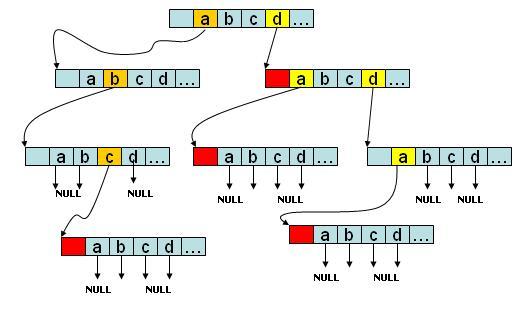先上图:
如下是 Trie 数的数据结构:

Trie 树的作用:统计,排序和保存字符串
快速查找某个单词key 所对应的 value 值(类似 Map 的功能)
(扩展的时候,可以判断某个 key 是否存在, 统计某个前缀被多少个单词占用(文章后面提到))
优点:
做查询的时候, 性能不会随着总的数据量增加而导致查询效率下降(空间换时间的思想)
(其他树形查找算法, 如二叉树查找, 性能会随着总的数据量增长而下降,而 Trie 树查找时的比较次数只跟 key 的长度有关系)
node 节点数据结构:
/**
* The node representation for the trie.
* @xsl.usage internal
*/
class Node
{
/**
* Constructor, creates a Node[ALPHA_SIZE].
*/
Node()
{
m_nextChar = new Node[ALPHA_SIZE];
m_Value = null;
}
/** The next nodes. */
Node m_nextChar[];
/** The value. */
Object m_Value;
}put()方法:
/**
* Put an object into the trie for lookup.
*
* @param key must be a 7-bit ASCII string,只处理128个字符
* @param value any java object.
*
* @return The old object that matched key, or null.
*/
public Object put(String key, Object value)
{
final int len = key.length();
if (len > m_charBuffer.length)
{
// make the biggest buffer ever needed in get(String)
//m_charBuffer用在 get 的时候用于装载key的字符数组,排除掉 key 过长的情况
m_charBuffer = new char[len];
}
//指向根节点
Node node = m_Root;
for (int i = 0; i < len; i++)
{
//检查该节点的m_nextChar数组中是否包含key.charAt(i)该字符
Node nextNode = node.m_nextChar[Character.toUpperCase(key.charAt(i))];
if (nextNode != null)
{
node = nextNode;
}
else
{
//向 node 节点插入剩余的字符
for (; i < len; i++)
{
Node newNode = new Node();
// put this value into the tree with a case insensitive key
//不区分大小写是为了在 get 的时候能忽略大小写
node.m_nextChar[Character.toUpperCase(key.charAt(i))] = newNode;
node.m_nextChar[Character.toLowerCase(key.charAt(i))] = newNode;
node = newNode;
}
break;
}
}
//把最终节点的旧的值return
Object ret = node.m_Value;
//node 节点的 value 指向传入的 value
node.m_Value = value;
return ret;
}get()方法:
public Object get(final String key)
{
final int len = key.length();
/* If the name is too long, we won't find it, this also keeps us
* from overflowing m_charBuffer
*/
if (m_charBuffer.length < len)
return null;
Node node = m_Root;
switch (len)
{
// case 0 looks silly, but the generated bytecode runs
// faster for lookup of elements of length 2 with this in
// and a fair bit faster. Don't know why.
case 0 :
{
return null;
}
//直接查询跟节点 Node
case 1 :
{
final char ch = key.charAt(0);
if (ch < ALPHA_SIZE)
{
node = node.m_nextChar[ch];
if (node != null)
return node.m_Value;
}
return null;
}
default :
{
key.getChars(0, len, m_charBuffer, 0);
// copy string into array
for (int i = 0; i < len; i++)
{
final char ch = m_charBuffer[i];
//非 ASCII码不处理
if (ALPHA_SIZE <= ch)
{
return null;
}
node = node.m_nextChar[ch];
if (node == null)
return null;
}
return node.m_Value;
}
}
}源码的数据结构是没法统计多少个单词占用了相同的前缀的.
要实现该功能, 则需要在 Node 节点中加入一个属性(如:sum), 每 put一个单词 到 Trie 树时, 所经过的字符都+1 ; 当需要统计某个前缀被多少个单词共用时, 直接读取该前缀的最后一个字符的sum 字段即可.
要使用 Trie 树判断某个 key 是否在树上, 可以在 Node 节点中加入一个boolean 标志位, 在插入每个单词的时候, 最后一个字符所在的 node 把标志位设置为 true 即可.(就实现了 set 的功能)
如果要实现 Trie 树排序的功能, 只需要先将所有 key 存入 Trie 树, 然后通过深度遍历的方式读取即可实现排序.
从源码看, Node根节点是存储数据的 , Trie对象有个属性m_Root指向最上层的 node 节点(根节点).
测试代码:
public static void main(String[] args) {
Trie trie = new Trie();
trie.put("adef", "yangyang");
trie.put("abg", "xiaochen");
Object tem = trie.get("ABG");
System.out.println(trie);
} 




















 3058
3058











 被折叠的 条评论
为什么被折叠?
被折叠的 条评论
为什么被折叠?








